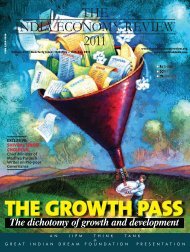Download - The India Economy Review
Download - The India Economy Review
Download - The India Economy Review
Create successful ePaper yourself
Turn your PDF publications into a flip-book with our unique Google optimized e-Paper software.
P LANNING P ARADIGM<br />
cies the government is announcing to<br />
welcome joint ventures or ‘opening up’<br />
of the mineral sector?<br />
* Will it reduce even a part of our everbloating<br />
unemployed labour?<br />
* Will it exhilarate the process of that<br />
model of ‘development’ projected by<br />
the Britton Woods Institutions?<br />
In general the devastation and human<br />
misery caused by mining, has been callously<br />
taken as an ‘acceptable price’ to<br />
pay for industrialisation and military<br />
might. In <strong>India</strong> the protagonist of this<br />
theory use the familiar term ‘National<br />
Development’. Well who makes a nation,<br />
a nation is a real question.<br />
<strong>The</strong> Power Hub Strategy!<br />
Power hub strategy is one of the core industrial<br />
strategies of mining and industrial<br />
development which has been given<br />
special emphasis both in the mining and<br />
industrial policies. With abundant coal<br />
reserves in the state power generation is<br />
easily possible. <strong>The</strong> total installed capacity<br />
in the State is approx. 3900 MW. Efforts<br />
are being made to encourage entrepreneurs<br />
to develop their own captive<br />
power projects. 17 During the past fi ve<br />
years all efforts have been made to turn<br />
the state into a power hub. According to<br />
the Industrial Policy, as part of the power<br />
hub strategy the government in a planned<br />
manner has signed Memorandum of Understanding<br />
(MoU) with public and private<br />
sector under to produce 50,000<br />
megawatt power. This would attract industries<br />
such as automobile, capital<br />
goods, steel and aluminum producers. 18<br />
a. Recent Developments in Energy &<br />
Power Sector<br />
According to a document of Government<br />
of <strong>India</strong> under the head “Consortium<br />
150 THE IIPM THINK TANK<br />
Lending” it is said that the Government<br />
of <strong>India</strong> envisions ‘Power for All’ by the<br />
year 2012 which requires ambitious target<br />
of augmentation of generating capacity<br />
by 100,000 MW. Like the other infrastructure<br />
projects, power projects are also<br />
highly capital intensive and have long<br />
gestation periods and a sizeable part of<br />
the investment is required to be made by<br />
the private sector. However, in the absence<br />
of uniformly acceptable approach,<br />
private sector projects are bound to face<br />
numerous hazards in obtaining fi nance<br />
like multiplicity of appraisal by participating<br />
institution, stipulation of different<br />
types of terms and conditions, different<br />
procedures/methodologies for disbursement<br />
and monitoring leading to delays in<br />
achieving fi nancial closure and expedi-<br />
tious project implementation. 19<br />
Realising the above situation, Power<br />
Finance Corporation (PFC) in association<br />
with Life Insurance Corporation<br />
(LIC) and four other <strong>India</strong>n Banks had<br />
established a Power Lenders’ Club (PLC)<br />
in August 2005 to provide single window<br />
fi nancing solutions for clients in the private<br />
power sector and to achieve expeditious<br />
fi nancial closure. It is essential to<br />
take a note that both PFC and LIC are<br />
Government of <strong>India</strong> undertaking. Subsequently,<br />
with the joining of Housing &<br />
Urban Development Corporation Ltd.<br />
(HUDCO) and eight other <strong>India</strong>n Banks,<br />
PLC has now emerged as a 21 members<br />
strong Club. <strong>The</strong> Consortium approach<br />
offered by Club would provide a comprehensive<br />
solution to the debt requirements<br />
of these projects without the developer<br />
having to queue up before a number of<br />
lenders to arrange for the funds. 20<br />
<strong>The</strong> PLC has already adopted a Common<br />
Loan Approach Form and standardized<br />
the loan documents for the convenience<br />
of the borrowers and lenders. As on<br />
date, PFC with some of the other members<br />
of PLC has been associated with<br />
funding of three power projects viz. 350<br />
MW Domestic Coal based project of<br />
RKM Power Gen in Chhattisgarh, 20<br />
MW Bagasse based project by Viswanath<br />
Sugar in Karnataka and 820 MW Konaseema<br />
Gas Based power project in AP.<br />
Further, M/s. IFFCO Chhattisgarh Power<br />
Ltd have placed a Letter of Intent on PFC<br />
for providing project advisory, appraisal<br />
and loan syndication services for their<br />
Govt in a planned manner has signed<br />
MoU with public & private sector to<br />
produce 50,000 megawatt power<br />
1000 MW power project to be set up in<br />
Chhattisgarh estimated cost Rs. 5400<br />
crore with debt component of Rs. 3780<br />
crore. 21<br />
With the aim to give impetus to Consortium<br />
Lending Operations, particularly<br />
through the PLC, PFC has recently established<br />
a Consortium Lending Group<br />
(CLG) headed by an Executive Director.<br />
<strong>The</strong> CLG shall work towards harnessing<br />
the huge business potential offered by the<br />
Power Sector. CLG is interacting with the<br />
Banks and Financial Institutions (FIs) to<br />
make an assessment regarding the cumulative<br />
exposure which could be taken by<br />
PLC members with a view to identify and<br />
fi rm up the various power projects to<br />
meet their funding requirements and to<br />
facilitate their expeditious fi nancial clo-





